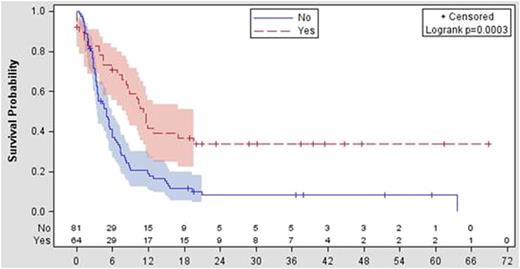Abstract

Salvage chemotherapy followed by high-dose therapy and autologous stem cell transplantation (ASCT) is the standard of care for relapsing/refractory DLBCL. In the CORAL study, there was no difference between two randomized second line regimens (R-DHAP or R-ICE) and only half of the patients (pts) eventually underwent per protocol ASCT (Gisselbrecht et al, JCO 2010 & 2012). Because outcome data are limited in DLBCL pts failing second-line strategy, 145 pts included in the CORAL study who failed R-DHAP or R-ICE and could not proceed to scheduled ASCT were herein reviewed.
Median age was 56y (range 20-67, 31% > 60y), M/F ratio 91/54, IPI 0-1 in 30%, 2-3 in 56%, and 4-5 in 14%. Third-line therapy consisted of ICE-type (19%), DHAP-type (19%), gemcitabine-containing (16%), CHOP-like (8%), dexaBEAM (8%), and miscellaneous (31%) regimens with or without rituximab according to centre policy. Overall response rate to third-line chemotherapy was 43%, with 21% complete response (CR), 8% CR unconfirmed (CRu), and 14% PR. CR/CRu and PR rates among pts treated with ICE-type, DHAP-type, gemcitabine-containing, or CHOP-like regimens were 23 and 23%, 35 and 8%, 9 and 4%, 25 and 25%, respectively. Among the 145 patients, 64 (44%) could eventually be transplanted (ASCT 56, allogeneic SCT 8).
Median overall survival (OS), calculated from time of second failure until death, was 5.9 months (95% CI 4.6-7.5; min: 0.0-max: 68.8 months; median follow-up: 32.8 months) and was not influenced by the type of third-line regimen (p=.49). OS was statistically different (p<.0001) according to IPI at CORAL failure: IPI 0-2: 11.1 months (1-y OS 42.9%), IPI > 2: 3.7 months (1-y OS 7.7%, HR 3.021). OS in pts achieving CR/CRu, PR, or no response after third-line regimen was 63.6 m (1-y OS 72.1%, p<.0001), 12.8 m (1-y OS 53.5%, p=.04), and 4.4 months (1-y OS 9.2%), respectively. Median OS of pts who could eventually be transplanted was 11.1 months (1-y OS 41.6%), as compared to a median OS of 5.0 months in those who were not transplanted (1-y OS 19.2%) with a HR of 2.182 (1.41-3.38, p<.0001, Figure 1). Median OS of pts transplanted in CR after third-line regimen was not reached as compared to those in PR (11.8 months) or those with no response (4.4 months, p<.0001). There was no statistically-significant difference in median OS between ASCT and alloSCT, taking into account the low numbers. In multivariate Cox analysis, IPI at relapse (HR 2.409) and transplantation (HR 0.381) independently predicted for OS.
OS (months) according to transplantation status in DLBCL pts after third-line regimen (No, no transplantation performed; Yes, transplantation performed).
OS (months) according to transplantation status in DLBCL pts after third-line regimen (No, no transplantation performed; Yes, transplantation performed).
Outcome of DLBCL pts failing second-line R-DHAP or R-ICE is overall poor. However, response to third-line therapy occurs, and 44% of the pts can be further transplanted. Long-term disease control can be observed, especially in pts achieving CR after third-line. This approach (salvage chemotherapy aiming at achieving response followed by transplantation) should then be encouraged in these patients, although there is obviously an urgent need for new drugs improving salvage efficacy.
Gisselbrecht:Roche: Consultancy, Research Funding; Baxter: Research Funding; Chugai Pharma: Research Funding. Trneny:Roche: Honoraria, Research Funding. Radford:Roche: Consultancy. Shpilberg:Roche: Consultancy, Honoraria, Research Funding. Dührsen:Roche Pharma: Honoraria, Research Funding. Moskowitz:Genentech: Consultancy, Research Funding. Glass:Roche: Honoraria, Research Funding.
Author notes
Asterisk with author names denotes non-ASH members.

This icon denotes a clinically relevant abstract


This feature is available to Subscribers Only
Sign In or Create an Account Close Modal